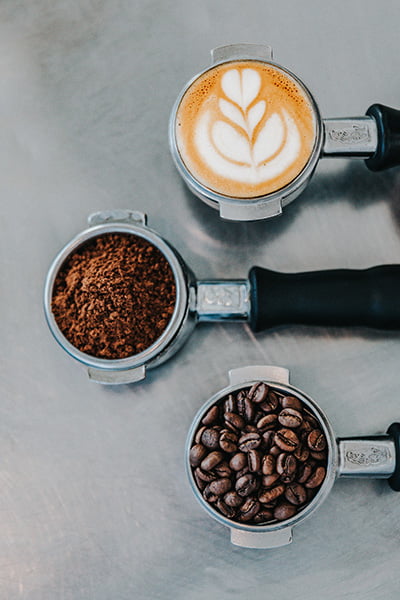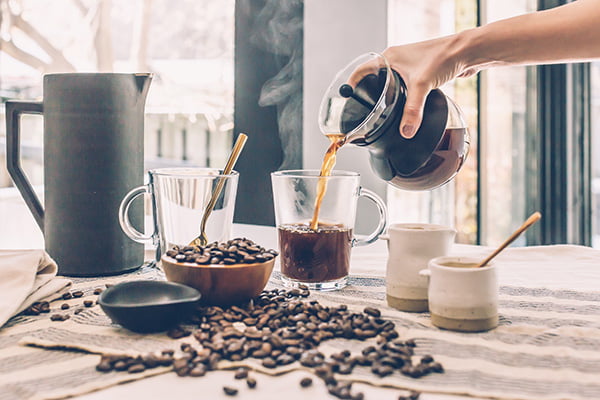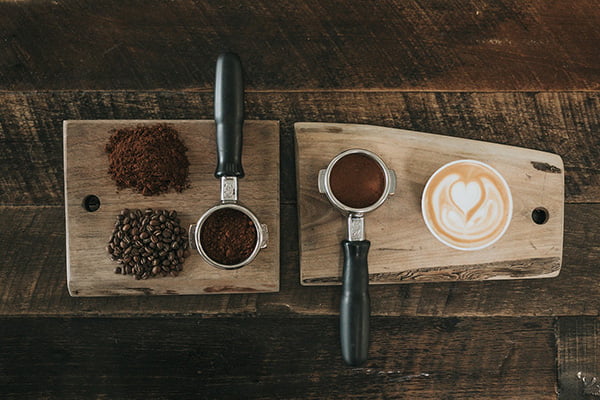There are not many drinks more popular - and some would say, necessary - than coffee. Its signature flavor, robust aroma, and, let's admit it, caffeine levels have made it a daily staple to many. In the United States, 80% of adults consume caffeine every day. According to the FDA, the average intake is 200 milligrams or about two 5 oz cups of coffee.
But that daily cup has been yanked back and forth in research studies - is it healthy? Is it harmful? Below, we look into what coffee is, what it means for your health, and how to pick the right type for you.
What Is Coffee?

Source: Unsplash
Coffee is a drink made from roasted coffee beans. Coffee beans are the seeds of a coffee cherry, and coffee cherries grow on coffee tree Coffea plants, and this makes coffee technically a fruit. And these coffee trees were originally grown in Southeast Asia and West Africa. Today, coffee cultivation of plants happens in over 70 countries, with most coffee being produced in Brazil, and Brazil produces 40% of the world's coffee.
The coffee seeds are removed from the coffee cherry and are then roasted. The roasted coffee beans are then ground into fine particles. This ground coffee is steeped in hot water and then filtered out, and you have a cup of coffee. Of course, there are many different ways to vary this process.
There are two types of coffee beans: Arabica and Robusta. Most coffee beans are Arabica, and Robusta is slightly more bitter and has twice as much caffeine.
Fun fact: The world's most expensive coffee is $600 a pound. And it comes from the feces of a Sumatran wildcat. Yep! An animal is called a Luwak. Luwak is unable to digest coffee beans. In the process of digesting the bean, they are fermented in the stomach. When the beans are extracted, they produce smooth chocolaty coffee.
How Does Coffee Taste?
Coffee is generally a bitter and slightly acidic drink. There is a wide range of flavor profiles, however. Some of this is based on the Coffea plant used to produce the coffee beans, to begin with, but the flavor can also be influenced by roasting times, roasting methods, and even how finely the coffee bean is ground. Some coffee drinkers use milk, cream, or various sweeteners to slightly cut the bitterness.
What are different types of coffee
There is a wide range of coffee varieties, each possessing distinctive traits and requiring specific brewing techniques. Let's explore a few popular coffee types:
Espresso: Espresso, a highly concentrated coffee drink, is created by applying intense pressure to hot water that is passed through finely-ground coffee beans. It serves as the foundation for numerous other coffee-based beverages.
Cappuccino: Cappuccino, an iconic Italian coffee beverage, is composed of equal proportions of espresso, steamed milk, and milk foam. Traditionally presented in a small cup, it is frequently adorned with a dusting of cocoa or cinnamon.
Latte: A latte shares similarities with a cappuccino, yet it features a greater amount of steamed milk and less foam. Typically, it consists of a shot of espresso combined with steamed milk, complemented by a modest layer of foam.
Macchiato: A macchiato is a beverage built upon espresso, where a shot of espresso is delicately "stained" with a small quantity of milk. It can be enjoyed in two variations: an espresso macchiato featuring a dollop of milk foam or a latte macchiato composed of steamed milk with a shot of espresso.
Americano: An Americano is an espresso-based beverage crafted by blending a shot of espresso with hot water, resulting in a milder flavor compared to pure espresso, yet stronger than drip coffee. It bears a resemblance to drip coffee in appearance and preparation.
Mocha: A mocha, also known as caffè mocha, harmoniously blends together espresso, steamed milk, and either chocolate syrup or cocoa powder. It is frequently garnished with whipped cream and chocolate shavings, adding a delightful touch of indulgence.
Flat White: The flat white, a well-liked espresso-based beverage originating from Australia and New Zealand, comprises a double shot of espresso accompanied by microfoam, which is steamed milk adorned with small, velvety bubbles. It boasts a robust coffee taste, accompanied by a luxuriously creamy texture.
Drip Coffee: Drip coffee, alternatively referred to as filtered coffee, involves the process of pouring hot water over finely ground coffee beans contained within a paper or metal filter. As a result, the freshly brewed coffee gradually filters through the filter and collects in a pot or carafe.
French Press: French press coffee is prepared by immersing coarse coffee grounds in hot water and allowing them to steep for a few minutes. Afterward, a plunger equipped with a mesh filter is pressed down to separate the grounds from the brewed coffee, resulting in a rich and flavorful cup of coffee.
Turkish Coffee: A cezve, a special pot, is used in the traditional method of brewing Turkish coffee by simmering finely ground coffee beans. This process produces a robust and aromatic coffee characterized by its dense and velvety texture.

Source: Pexels
What To Consider When Buying Coffee Beans
When buying coffee beans, several factors can significantly impact the taste and quality of your caffeinated and decaffeinated coffee.
Type of Bean
While there are a wide variety of coffee plants, there are two that are dominant. Coffea arabica and Coffea canephora, commonly called Coffea robusta, are the two predominant species of coffee beans that are extensively cultivated.
Here are some types of coffee beans within these species:
Arabica: Coffea Arabica originated from Ethiopia and produced a milder flavorful coffee than other types. However, it's more sensitive to sunlight and humidity levels and requires a steady temperature between 60 and 75 degrees Fahrenheit. So it's more expensive to grow.
Arabica beans are generally renowned for their superior quality and offer a nuanced and delicate flavor profile, distinguishing them from robusta beans. They account for most of the world's coffee production, and arabica beans are grown at higher altitudes, contributing to their desirable flavor.
Robusta: While robusta beans are commonly regarded as lower quality, they are highly prized for their elevated caffeine content and remarkable resilience against pests and diseases. They are frequently utilized in blends and instant coffee preparations. Compared to arabica beans, robusta beans offer a more robust and bitter flavor profile.
Roast Level
The rich flavor and strong aroma that we all associate with coffee come about when the green coffee bean is roasted. All coffee beans are roasted at high heat, but exactly how high the heat and how long they're roasted change their flavor. Roasting levels range from light (or blonde) to medium to dark. Here are some commonly recognized coffee roast levels:
Light Roast
During the roasting process, light roast coffee beans are subjected to a shorter duration, which helps retain a greater portion of their original flavor and acidity. This results in light brown-colored beans with lighter bodies. Light roasts often exhibit vibrant and nuanced flavors with notes of fruit, floral, or tea-like qualities.
Medium Roast
Medium roast coffee beans exhibit a medium brown hue and undergo a slightly longer roasting period than light roasts. This roast level balances preserving the bean's original flavors and developing richer, caramelized notes. Medium roasts generally have a well-rounded flavor profile with a balanced acidity, sweetness, and body balance. They may offer a range of flavors, including chocolate, nuts, and a moderate level of acidity.
Medium-Dark Roast
With a rich and deep dark brown color, medium-dark roast coffee beans display a slightly oily surface. They are roasted longer than medium roasts, resulting in a stronger flavor and reduced acidity. Medium-dark roasts often exhibit a bittersweet flavor profile with prominent notes of chocolate and caramel. The body is fuller, and the acidity is more subdued.
Dark Roast
Dark roast coffee beans are meticulously roasted until they achieve a profound, dark brown, or nearly black color, boasting a glossy and oily surface. Dark roasts are characterized by their bold, intense flavors and smoky, roasted notes. The roasting process largely masks the original flavors of the beans. Dark roasts are characterized by their full-bodied nature, lower acidity, and a potential hint of slight bitterness in taste. Common dark roasts include French roast, Italian roast, and Spanish roast.
Extra Dark Roast
Extra dark roast coffee beans are roasted beyond the dark roast level, producing extremely dark and shiny beans. The beans have a very low acidity and are characterized by strong, smoky flavors and a pronounced bitterness. Extra dark roasts are often used in espresso blends and are less common for regular brewed coffee.
Grind Level
The grind level of coffee pertains to the size of the coffee particles once the beans have been ground. The ground level is a crucial factor in determining the extraction and flavor profile of the coffee when brewed. Optimal results in various brewing methods necessitate specific grind sizes. Here are some common coffee grind levels:
Coarse Grind: Coarse grind is characterized by large coffee particles that resemble rough sea salt or breadcrumbs. This ground level is typically used for brewing methods that require longer steeping or infusion times, such as cold brew or French press.
Medium-Coarse Grind: Medium-coarse grind has particles similar in size to coarse sand. It is frequently employed in pour-over or percolator brewing methods.
Medium Grind: Medium grind has a texture resembling regular table salt, and it is suitable for drip coffee or Aeropress.
Medium-Fine Grind: Medium-fine grind has a texture similar to sand but slightly finer. It is well-suited for pour-over or siphon brewing.
Fine Grind: Fine grind has a texture comparable to granulated sugar. It is commonly employed in espresso or moka pot brewing methods.
Extra-Fine Grind: Extra-fine grind has a powdery consistency, similar to flour. It is primarily used for Turkish coffee.
Caffeine Level
Coffee naturally has caffeine, but it can be removed by either using chemical solvents or carbon dioxide gas. Both methods will remove some coffee flavor, scent, and caffeine. Here's a general overview of caffeine levels in different types of coffee:
Arabica Coffee: Arabica coffee beans, which are generally considered higher quality, contain lower caffeine levels than robusta beans.
Robusta Coffee: Compared to arabica beans, robusta coffee beans have a higher caffeine content and almost twice as much as Arabica.
Brewed Coffee: The caffeine content in brewed coffee can fluctuate based on the brewing technique and the brew's potency. On average, an 8-ounce (240 ml) cup of brewed coffee contains approximately 95 milligrams of caffeine. Nevertheless, the actual caffeine levels can span from 30 to 200 milligrams or even higher, influenced by factors such as the type of coffee bean, roast intensity, and brewing variables.
Espresso: Typically, a single shot of espresso, measuring approximately 1 ounce or 30 ml, contains around 65 milligrams of caffeine. However, since espresso is often consumed in smaller volumes, the total caffeine intake can be higher when consuming multiple shots or larger espresso-based drinks like lattes or cappuccinos.
Instant Coffee: In general, instant coffee tends to have slightly lower caffeine levels when compared to brewed coffee. An 8-ounce (240 ml) cup of instant coffee typically contains around 60 milligrams of caffeine, although this can vary depending on the brand and serving size.

Source: Pixabay
What is the difference between caffeinated and decaffeinated coffee
The main difference between caffeinated and decaffeinated coffee lies in its caffeine content. Caffeinated coffee contains varying amounts of natural caffeine, while decaffeinated coffee has removed a significant portion of its caffeine content.
Coffee that contains caffeine is known for its natural stimulant properties, which can enhance energy levels and promote alertness. The precise amount of caffeine present in coffee varies based on factors like the type of coffee bean, roast intensity, brewing technique, and serving size. On average, an 8-ounce (240 ml) cup of brewed coffee contains approximately 95 milligrams of caffeine.
Decaffeinated coffee is specially processed to remove a significant portion of the caffeine present in the beans. Although decaffeinated coffee is not completely devoid of caffeine, it generally possesses significantly lower levels of caffeine compared to regular coffee. The actual caffeine content can vary depending on the decaffeination process and brand, but it is generally reduced to around 2 milligrams per 8-ounce (240 ml) cup.
Is Drinking Coffee Healthy?
Is coffee even healthy in the first place? Depends! Coffee is a mixture of over a thousand chemicals, so each person's reaction to coffee can vary widely. This makes it hard for researchers to reach a definite conclusion. Currently, the research seems to say that moderate coffee consumption has positive health outcomes.
Potential Health Benefits
- Coffee contributes to your daily nutrient value. A single cup of coffee contains 11% of the daily recommended amount of Riboflavin (vitamin B2), 6 % of Pantothenic acid (vitamin B5), 3% of manganese and potassium, and 2% of niacin and magnesium.
- Low to moderate caffeine consumption increases alertness, energy, and concentration ability. These are all good things!
- Cancer research has shown the benefits of drinking coffee. Coffee seems to speed digestion, resulting in a lower risk of colorectal cancer. It decreases estrogen levels, reducing the risk of several types of cancer. It also lowers inflammation, which can lead to all sorts of cancers.
- While caffeine increases blood sugar in the short-term, long-term coffee consumption shows a slightly lower risk of type 2 diabetes. The polyphenols and magnesium in coffee seem to lead to a reduced risk of insulin resistance.
- While caffeine is a stimulant, drinking coffee regularly is associated with a significantly decreased risk of getting heart disease and stroke. This risk appears to get lower as coffee consumption increases, with people who drink upwards of 4 or more cups a day showing a 20% lower risk of stroke than people who don't drink coffee. Moderate coffee drinking (around 3 cups a day) also lowers the risk of heart disease and death by 21%.
- Depression and suicide risks go down notably as coffee consumption increases.
- Low dopamine levels mainly cause Parkinson's disease. Studies have found caffeine to protect the brain cells that produce dopamine.
Negative Health Outcomes
- High levels of caffeine from drinking multiple cups of coffee daily can lead to anxiety, panic attack, restlessness, insomnia, and an increased heart rate.
- In certain individuals, drinking caffeinated coffee can lead to undesirable heart palpitations. Unfiltered coffee brews contain substances that can raise triglycerides and cholesterol, causing issues with blood pressure.
- Consuming coffee, especially in the afternoon or evening, can interfere with sleep quality and quantity. Caffeine is known to stimulate the central nervous system and can make it difficult to fall asleep or stay asleep. It is generally recommended to avoid consuming coffee close to bedtime or to switch to decaffeinated options if you are sensitive to caffeine's effects on sleep.
- Coffee can irritate the gastrointestinal system in some individuals. It has the potential to induce symptoms like acid reflux, heartburn, stomach discomfort, or diarrhea. This is often attributed to the acidic nature of coffee or its ability to increase stomach acid production. People with pre-existing gastrointestinal conditions may be more prone to these effects.
- Excessive or regular coffee consumption can lead to caffeine dependence. Your body may become accustomed to the stimulating effects of caffeine. If you attempt to abruptly reduce or cease consumption, you may encounter withdrawal symptoms like headaches, fatigue, irritability, and difficulty concentrating. Gradually reducing caffeine intake or seeking guidance from a healthcare professional can help manage caffeine withdrawal symptoms.
- Caffeine can interact with certain medications, including those used for blood pressure, heart conditions, anxiety disorders, and medications that affect liver function. To ensure a comprehensive understanding of potential interactions between coffee and your medications, it is crucial to seek guidance from your healthcare provider or pharmacist.
- Coffee contains pigments that can stain tooth enamel over time, leading to a yellowish appearance of the teeth. Consistent oral hygiene practices can assist in alleviating this effect.
In short, drinking moderate amounts of coffee a day poses significant health benefits. However, if caffeine tends to give you the jitters, those health benefits will be outweighed by anxiety, lack of sleep, and the strain of a regular increased heart rate.
